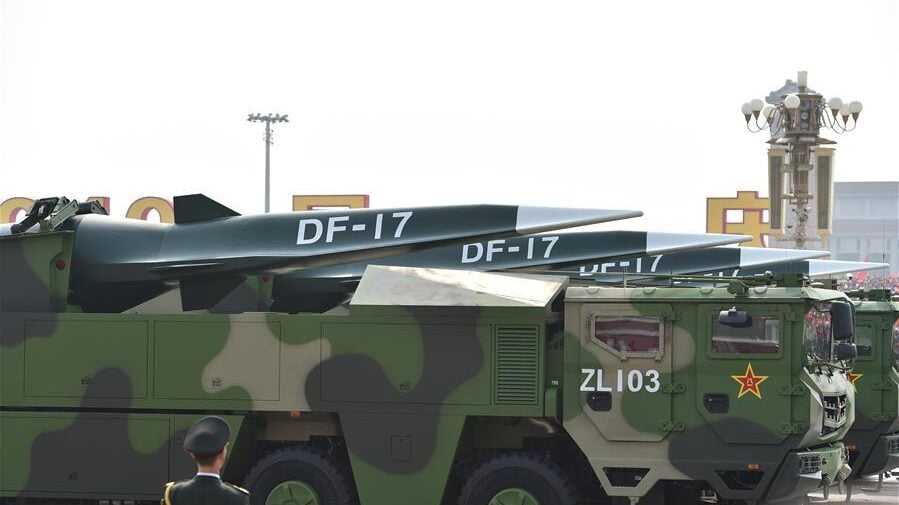
China’s DF-17 missile can reach Low Earth Orbit (Chinese Ministry of Defense)
WASHINGTON: In an attempt to fan away some of the fog generated by weeks of hair-raising but vague and sometimes contradictory public reports, a senior Space Force official today made it clear that Beijing’s weapons test earlier this year involved a fractional orbital bombardment system (FOBS) that deployed a hypersonic glide vehicle.
“I think the words that we use are important, so that we understand exactly what we’re talking about here. I hear things like hypersonic missile, and I hear suborbital sometimes,” Lt. Gen. Chance (Salty) Saltzman, deputy Space Force chief for operations, told the Mitchell Institute. It is neither of those things, he stressed.
“This is a categorically different system, because a fractional orbit is different than suborbital. A fractional orbit means it can stay on orbit as long as the user determines and then it de-orbits it as a part of the flight path.”
Further, he added, it is a “very forward-edge technology capability” that Space Force quickly must figure out how to deter.
Air Force Secretary Frank Kendall first suggested that the test involved a FOBS in late September during the Air Force Association’s annual trade show. A FOBS uses a rocket to boost its payload into Low Earth Orbit, which subsequently de-orbits through the atmosphere to its terrestrial target.
The Soviet Union actually deployed a nuclear-weapons-carrying FOBS from 1969 to 1983. The Chinese system is different, however, because it de-orbited a highly maneuverable hypersonic glide vehicle (HGV).
Weapons systems that flirt with orbital trajectories also flirt with violating the 1967 Outer Space Treaty‘s prohibition on stationing nuclear weapons in orbit. But during the Cold War the Soviet Union argued the original FOBS was above board because the spacecraft carrying the warhead did not make an entire rotation of the Earth before dropping its deadly payload. Washington then, as now, concurred with that hair-splitting interpretation — which also has been applied by both sides to intercontinental ballistic missiles (ICBMs).
However, Saltzman explained, a FOBS is not the same thing as a ballistic missile, the latter of which are easy to track because of their predictable trajectories. Because it is unclear where a FOBS might release its payload to allow it to come back to Earth, it is difficult to predict where its weapon will impact. And a FOBS/HGV hybrid presents even more tracking challenges, because unlike a nuclear re-entry vehicle, an HGV is highly maneuverable.
“A lot of our warning, you know, is based on ballistic missiles because that’s the been the primary threat for so many years,” he said. “And so it’s incumbent on the Space Force, in my mind, to make sure that we’re developing the capabilities to track these kinds of weapons. Before they’re launched, ideally, but then throughout their lifecycle — either on orbit or in execution of their mission set.”
He added that “if we can track we can attribute … I think we can deter.” Thus, it is imperative for Space Force “to make sure that we’re developing those capacities to be able to track and hold accountable nations who are using these kinds of destabilizing weapons.”
Saltzman noted that the Chinese test is an example of the fact that for the moment in space “whoever can go first on the offense [has] an advantage.” It is now the job of the US military, and Space Force in particular, to “offset” that advantage.
“We have to figure out how you defend against that capability so that that first mover advantage is not there,” and the relationship between offensive and defensive technology “rebalances and creates stability across the entire environment,” he said.
In the meantime, there are questions that need answers, he said, like, “How do we get more out of our current capabilities? Where do we need to fill some gaps or some holes in our sensors? … How do we leverage artificial intelligence to warn us about things that maybe the human eye can’t see or detect fast enough?”
Saltzman said those are “all the things that we’re pursuing from a research and development/science and technology standpoint, so that we can restore that strategic stability.”
However, Saltzman did not address directly two of the remaining questions about the Chinese system itself: whether, as some officials have suggested, the Chinese FOBS/HGV hybrid is designed to carry nuclear weapons; and if the test involved the HGV itself deploying a hypersonic missile or countermeasure while itself screaming through the atmosphere toward a target at speeds greater than Mach 5.
The latter scenario, one expert previously told Breaking Defense, would be “super impressive.”






















